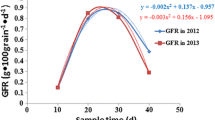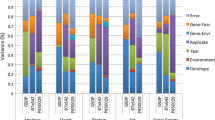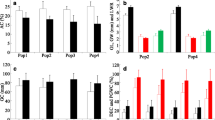Abstract
To ensure food security in Africa and Asia, developing sorghum varieties with grain quality that matches consumer demand is a major breeding objective that requires a better understanding of the genetic control of grain quality traits. The objective of this targeted association study was to assess whether the polymorphism detected in six genes involved in synthesis pathways of starch (Sh2, Bt2, SssI, Ae1, and Wx) or grain storage proteins (O2) could explain the phenotypic variability of six grain quality traits [amylose content (AM), protein content (PR), lipid content (LI), hardness (HD), endosperm texture (ET), peak gelatinization temperature (PGT)], two yield component traits [thousand grain weight (TGW) and number of grains per panicle (NBG)], and yield itself (YLD). We used a core collection of 195 accessions which had been previously phenotyped and for which polymorphic sites had been identified in sequenced segments of the six genes. The associations between gene polymorphism and phenotypic traits were analyzed with Tassel. The percentages of admixture of each accession, estimated using 60 RFLP probes, were used as cofactors in the analyses, decreasing the proportion of false-positive tests (70%) due to population structure. The significant associations observed matched generally well the role of the enzymes encoded by the genes known to determine starch amount or type. Sh2, Bt2, Ae1, and Wx were associated with TGW. SssI and Ae1 were associated with PGT, a trait influenced by amylopectin amount. Sh2 was associated with AM while Wx was not, possibly because of the absence of waxy accessions in our collection. O2 and Wx were associated with HD and ET. No association was found between O2 and PR. These results were consistent with QTL or association data in sorghum and in orthologous zones of maize. This study represents the first targeted association mapping study for grain quality in sorghum and paves the way for marker-aided selection.



Similar content being viewed by others
References
Aboubacar A, Hamaker BR (1999) Physicochemical properties of flours that relate to sorghum couscous quality. Cereal Chem 76:308–313
Agrama HA, Eizenga GC, Yan W (2007) Association mapping of yield and its components in rice cultivars. Mol Breed 19:341–356
Andersen JR, Schrag T, Melchinger AE, Zien I, Lübberstedt T (2005) Validation of Dwarf8 polymorphisms associated with flowering time in elite European inbred lines of maize. Theor Appl Genet 111:206–217
Ayres NM, McClung AM, Larkin PD, Bligh HFJ, Jones CA, Park WD (1997) Microsatellites and a single-nucleotide polymorphism differentiate apparent amylose classes in an extended rice pedigree of US rice germplasm. Theor Appl Genet 94:773–781
Belton PS, Taylor JRN (2004) Sorghum and millets: protein sources for Africa. Trends Food Sci Technol 15:94–98
Bradbury PJ, Zhang Z, Kroon DE, Casstevens TM, Ramdoss Y, Buckler ES (2007) TASSEL: software for association mapping of complex traits in diverse samples. Bioinformatics 23:2633–2635
Breseghello F, Sorrells ME (2006) Association mapping of kernel size and milling quality in wheat. Genetics 172:1165–1177
Brown PJ, Rooney WL, Franks C, Kresovich S (2008) Efficient mapping of plant height quantitative trait loci in a sorghum association population with introgressed dwarfism genes. Genetics 180:629–637
Buckler ES, Thornsberry JM (2002) Plant molecular diversity and applications to genomics. Curr Opin Plant Biol 5:107–111
Buntjer JB, Sorensen AP, Peleman JD (2005) Haplotype diversity: the link between statistical and biological association. Trends Plant Sci 10:466–471
Camus-Kulandaivelu L, Veyrieras JB, Madur D, Combes V, Fourmann M, Barraud S, Dubreuil P, Gouesnard B, Manicacci D, Charcosset A (2006) Maize adaptation to temperate climate: relationship between population structure and polymorphism in the Dwarf8 gene. Genetics 172:2449–2463
Chantereau J, Trouche G, Luce C, Deu M, Hamon P (1997) Le Sorgho. In: Charrier A, Jacquot M, Hamon S, Nicolas D (eds) L’amélioration des plantes tropicales. Cirad and Orstom, Montpellier, pp 565–590
Cockram J, White J, Leigh FJ, Lea VJ, Chiapparino E, Laurie DA, Mackay IJ, Powell W, O’Sullivan DM (2008) Association mapping of partitioning loci in barley. BMC Genetics 9:1–14
de Alencar Figueiredo LF, Davrieux F, Fliedel G, Rami J-F, Chantereau J, Deu M, Courtois B, Mestres C (2006) Development of NIRS equations based on a core collection to predict quality traits in sorghum grain. J Agric Food Chem 54:8501–8509
de Alencar Figueiredo LF, Calatayud C, Dupuis C, Billot C, Rami JF, Brunel D, Perrier X, Courtois B, Deu M, Glaszmann J-C (2008) Phylogeographic evidence of crop neo-diversity in sorghum. Genetics 179:997–1008
Deu M, Gonzàlez-de-Leòn D, Glaszmann J-C, Dégremont I, Chantereau J, Lanaud C, Hamon P (1994) RFLP diversity in cultivated sorghum in relation to racial differentiation. Theor Appl Genet 88:838–844
Deu M, Rattunde F, Chantereau J (2006) A global view of genetic diversity in cultivated sorghums using a core collection. Genome 49:168–180
Devlin B, Roeder K (1999) Genomic control for association studies. Biometrics 55:997–1004
Doebley J, Bacigalupo A, Stec A (1994) Inheritance of kernel weight in two maize–teosinte hybrid populations: implications for crop evolution. J Hered 85:191–195
Doggett H (1988) Sorghum, 2nd edn. Longman, New York (512 pp)
Evanno G, Regnaut S, Goudet J (2005) Detecting the number of clusters of individuals using the software Structure: a simulation study. Mol Ecol 14:2611–2620
Fliedel G (1994) Evaluation de la qualité du sorgho pour la fabrication du tô. Agriculture et développement 34:12–21
Fliedel G, Marti A, Thiebaut S (1996) Caractérisation et valorisation du sorgho. Cirad Montpellier, 404 pp
Flint-Garcia SA, Thornsberry JM, Buckler ES (2003) Structure of linkage disequilibrium in plants. Annu Rev Plant Biol 53:357–374
Gao H, Williamson S, Bustamante C (2007) An MCMC approach for joint inference of population structure and inbreeding rates from multi-locus genotype data. Genetics 176:1635–1651
Gebhardt C, Ballvora A, Walkemeier B, Oberhagemann P, Schüler K (2004) Assessing genetic potential in germplasm collections of crop plants by marker–trait association: a case study for potatoes with quantitative variation of resistance to late blight and maturity type. Mol Breed 13:93–102
Goldman LL, Rocheford TR, Dudley JW (1993) Quantitative trait loci influencing protein and starch concentration in Illinois long term selection maize strains. Theor Appl Genet 87:217–224
Hamblin MT, Salas Fernandez MG, Casa AM, Mitchell SE, Paterson AH, Kresovich S (2005) Equilibrium processes cannot explain high levels of short- and medium-range linkage disequilibrium in the domesticated grass Sorghum bicolor. Genetics 171:1247–1256
Hamblin MT, Salas Fernandez MG, Tuinstra MR, Rooney WL, Kresovich S (2007) Sequence variation at candidate loci in the starch metabolism pathway in sorghum: prospects for linkage disequilibrium mapping. Plant Genome 2:125–134
Harlan JR, de Wet JMJ (1972) A simplified classification of cultivated sorghum. Crop Sci 12:172–176
Henry AM, Damerval C (1997) High rates of polymorphism and recombination at the Opaque-2 locus in cultivated maize. Mol Gen Genet 256:147–157
Ihaka R, Gentleman R (1996) R: a language for data analysis and graphics. J Comput Graph Stat 5:299–314
James MG, Denyer K, Myers AM (2003) Starch synthesis in the cereal endosperm. Curr Opin Plant Biol 6:215–222
Kraakman ATW, Niks RE, Van den Berg PMMM, Stam P, VanEuuwijk FA (2004) Linkage disequilibrium mapping of yield and yield stability in modern spring barley cultivars. Genetics 168:435–446
Larkin PD, McClung AM, Ayres NM, Park WD (2003) The effect of the Waxy locus (Granule Bound Starch Synthase) on pasting curve characteristics in specialty rices. Euphytica 131:243–253
Lopes MA, Larkins BA (1991) Gamma-zein content is related to endosperm modification in quality protein maize. Crop Sci 31:1655–1662
Maddaloni M, Donini G, Balconi C, Rizzi E, Gallusci P, Forlani F, Lohmer S, Thompson R, Salamini F, Motto M (1996) The transcriptional activator Opaque-2 controls the expression of a cytosolic form of pyruvate orthophosphate dikinase-1 in maize endosperms. Mol Gen Genet 250:647–654
Manicacci D, Falque M, Le Guillou S, Piegu B, Henry A-M, Le Guilloux M, Damerval C, De Vienne D (2007) Maize Sh2 gene is constrained by natural selection but escaped domestication. J Evol Biol 20:503–516
McIntyre CL, Drenth J, Gonzalez N, Henzell RG, Jordan DR (2008) Molecular characterization of the waxy locus in sorghum. Genome 51:524–533
Motto M, Hartings H, Maddaloni M, Lohmer S, Salamini F, Thompson R (1996) Genetic manipulation of protein quality in maize grains. Field Crop Res 45:37–48
Murray SC, Sharma A, Rooney WL, Klein PE, Mullet JE, Mitchell SE, Kresovich S (2008) Genetic improvement of sorghum as a biofuel feedstock: I. QTL for stem sugar and grain non-structural carbohydrates. Crop Sci 48:2165–2179
Murray SC, Rooney WL, Hamblin MT, Mitchell SE, Kresovich S (2009) Sweet sorghum genetic diversity and association mapping for brix and height. Plant Genome 2:48–62
Myers AM, Morell MK, James MG, Ball SG (2000) Recent progress toward understanding biosynthesis of the amylopectin crystal. Plant Physiol 122:989–998
Nielsen R (2005) Molecular signatures of natural selection. Annu Rev Genet 39:197–218
Nishi A, Nakamura Y, Tanaka N, Satoh H (2001) Biochemical and genetic analysis of the effects of amylose-extender mutation in rice endosperm. Plant Physiol 127:459–472
Ollitrault P (1987) Evaluation génétique des sorghos cultivés (Sorghum bicolor L. Moench) par l’analyse conjointe des diversités enzymatique et morphophysiologique. Relations avec les sorghos sauvages. PhD Thesis, Université Paris XI Orsay, 187 pp
Olsen KM, Purugganan MD (2002) Molecular evidence on the origin and evolution of glutinous rice. Genetics 162:941–950
Perrier X, Jacquemoud-Collet JP (2006) DARwin software. Available at http://darwin.cirad.fr/darwin
Pirovano L, Lanzini S, Hartings H, Lazzaroni N, Rossi V, Joshi R, Thompson RD, Salamini F, Motto M (1994) Structural and functional analysis of an Opaque-2-related gene from sorghum. Plant Mol Biol 24:515–523
Price AL, Patterson NJ, Plenge RM, Weinblatt ME, Shadick NA, Reich D (2006) Principal component analysis corrects for stratification in genome-wide association studies. Nat Genet 38:904–909
Pritchard JK, Stephens M, Donnelly P (2000a) Inference of population structure using multilocus genotype data. Genetics 155:945–959
Pritchard JK, Stephens M, Rosenberg NA, Donnelly P (2000b) Association mapping in structured populations. Am J Hum Genet 67:170–181
Rami JF (1999) Etude des facteurs génétiques impliqués dans la qualité technologique du grain chez le maïs et le sorgho. PhD thesis, Orsay University, 96 pp
Rami JF, Dufour P, Trouche G, Fliedel G, Mestres C, Davrieux F, Blanchard P, Hamon P (1998) Quantitative trait loci for grain quality, productivity, morphological and agronomical traits in sorghum (Sorghum bicolor L. Moench). Theor Appl Genet 97:605–616
Schultz JA, Juvik JA (2004) Current models for starch synthesis and the sugary enhancer1 (se1) mutation in Zea mays. Plant Physiol Biochem 42:457–464
Séne M, Causse M, Damerval C, Thévenot C, Prioul J-L (2000) Quantitative trait loci affecting amylose, amylopectin and starch content in maize recombinant inbred lines. Plant Physiol Biochem 38:459–472
Séne M, Thévenot C, Hoffmann D, Bénétrix F, Causse M, Prioul J-L (2001) QTLs for grain dry milling properties, composition and vitreousness in maize recombinant inbred lines. Theor Appl Genet 102:591–599
Sine B (2003) Evaluation d’une core collection de sorgho en conditions de stress hydrique pré-floral. Master University Cheikh Anta Diop, Dakar, Sénégal, 67 pp
Skot L, Humphreys MO, Armstead I, Heywood S, Skot KP, Sanderson R, Thomas ID, Chorlton KH, Sackville Hamilton NR (2005) An association mapping approach to identify flowering time genes in natural populations of Lolium perenne. Mol Breed 15:233–245
Thornsberry JM, Goodman MJ, Doebley J, Kresovich S, Nielsen D, Buckler ED (2001) Dwarf8 polymorphisms associate with variation in flowering time. Nat Genet 28:286–289
Tian Z, Qian Q, Liu Q, Yan M, Liu X, Yan C, Liu G, Gao Z, Tang S, Zeng D, Wang Y, Yu J, Gu M, Li J (2009) Allelic diversities in rice starch biosynthesis lead to a diverse array of rice eating and cooking qualities. Proc Natl Acad Sci USA 106:21760–21765
Vasemägi A, Primmer RC (2005) Challenges for identifying functionally important genetic variation: the promise of combining complementary research strategies. Mol Ecol 14:3623–3642
Vigouroux Y, McMullen M, Hittinger CT, Houchins K, Schulz L, Kresovich S, Matsuoka Y, Doebley J (2002) Identifying genes of agronomic importance in maize by screening microsatellites for evidence of selection during domestication. Proc Natl Acad Sci USA 99:9650–9655
Wendorf F, Close AE, Schild R, Wasylikowa K, Housley RA, Harlan JR, Krolik H (1992) Saharan exploitation of plants 8000 years BP. Nature 359:721–724
Wilson LM, Whitt SR, Ibanez AM, Rocheford TR, Goodman MM (2004) Dissection of maize kernel composition and starch production by candidate gene association. Plant Cell 16:2719–2733
Yetneberk S, de Kock HL, Rooney LW, Taylor JRN (2004) Effects of sorghum cultivar on injera quality. Cereal Chem 81:314–321
Yu J, Pressoir G, Briggs WH, Vroh BI, Yamasaki M, Doebley JF, McMullen MD, Gaut BS, Nielsen DM, Holland JB, Kresovich S, Buckler ES (2006) A unified mixed-model method for association mapping that accounts for multiple levels of relatedness. Nat Genet 38:203–208
Yu J, Zhang Z, Zhu C, Tabanao DA, Pressoir G, Tuinstra MR, Kresovich S, Todhunter RJ, Buckler ES (2009) Simulation appraisal of the adequacy of number of background markers for relationship estimation in association mapping. Plant Genome 2:63–77
Acknowledgments
The authors gratefully acknowledge the financial support from the GABI-Génoplante project “Bridging genomics and genetic diversity: associations between gene polymorphism and trait variation in cereals” for the sequencing of O2, and from the CNPq and from the Universidade Católica de Brasília through a grant to L.F. de A.F.
Author information
Authors and Affiliations
Corresponding author
Additional information
Communicated by J. Yu.
Electronic supplementary material
Below is the link to the electronic supplementary material.
Rights and permissions
About this article
Cite this article
de Alencar Figueiredo, L.F., Sine, B., Chantereau, J. et al. Variability of grain quality in sorghum: association with polymorphism in Sh2, Bt2, SssI, Ae1, Wx and O2 . Theor Appl Genet 121, 1171–1185 (2010). https://doi.org/10.1007/s00122-010-1380-z
Received:
Accepted:
Published:
Issue Date:
DOI: https://doi.org/10.1007/s00122-010-1380-z




